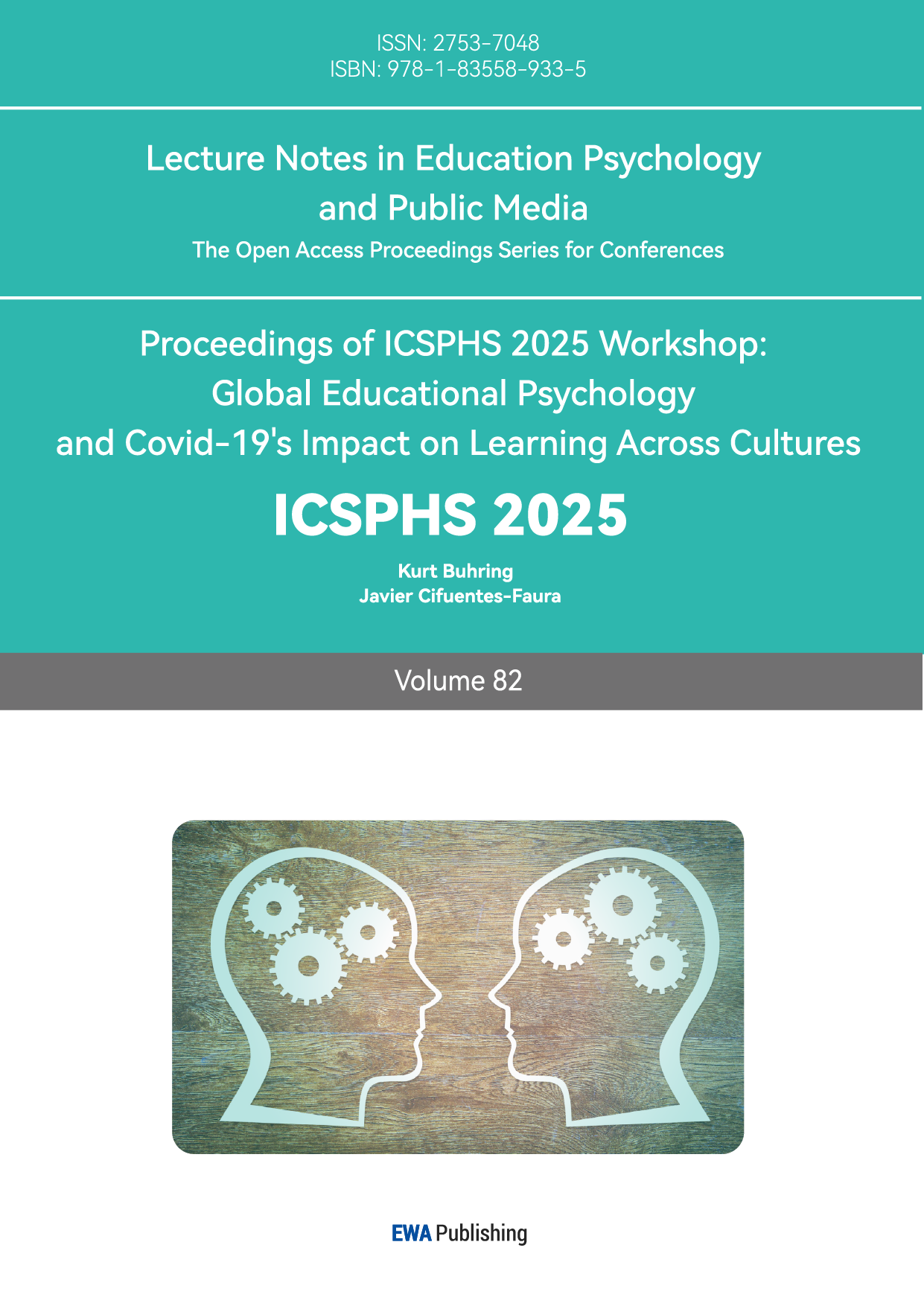1.Introduction
On July 24, 2021, the General Office of the Central Committee of the Communist Party of China and the General Office of the State Council issued the "Opinions on Further Reducing the Homework Burden and Off-Campus Training Burden for Students in Compulsory Education," commonly referred to as the "Double Reduction" policy. This policy targets students in the compulsory education stage, aiming to alleviate both schoolwork and off-campus training burdens.
1.1.Current Research on Parent-Child Relationships and Influencing Factors
Parent-child relationships refer to the quality of emotional bonds, interactions, and support between parents and their children. They are commonly defined as the emotional connections and interaction patterns between parents or guardians and their children [1-4]. As a core component of family education, parent-child relationships encompass multiple dimensions, including emotional support, communication quality, and the frequency and quality of parent-child interactions [5]. These dimensions are interrelated.
Specifically, in terms of communication quality and emotional support, studies have examined the importance of communication and support in parent-child relationships [6], emphasizing the influence of parental communication styles on children's early learning during academic tasks [5]. Findings suggest that effective parent-child communication contributes to children's academic achievement. Research on the frequency and quality of parent-child interactions often explores how low-quality interactions affect emotional support and communication outcomes [7-10]. For example, some studies have investigated cognitive differences between mothers and children in reporting child abuse [11], as well as the effects of socioeconomic status and domestic violence [12,13]. Additionally, other studies have examined children's roles in power and control dynamics within domestic and intimate partner violence [14], reflecting power dynamics in parent-child relationships.
Beyond the multi-dimensional nature of parent-child relationships, they are influenced by various factors, including family background, individual traits, and available social support and resources. Family economic status and educational levels determine the material and psychological resources parents can provide to their children, impacting the quality and frequency of parent-child interactions [15-17]. Moreover, family stability—such as the harmony of parental marital relationships—has profound effects on parent-child relationships. Family financial status, educational background, and structural stability significantly influence parent-child relationships [18]. Additionally, individual traits and experiences, such as parental personality, emotional well-being, and beliefs about child-rearing, also play critical roles [14,19]. For instance, parental beliefs, stress, and attitudes influence children's screen time, which in turn affects parent-child interactions and child development [20]. Meanwhile, children’s sensitivity and behavioural issues can reciprocally impact the quality of parent-child relationships.
To measure parent-child relationship quality more accurately, researchers have employed various tools and methods. Commonly used approaches include surveys and observational studies. Surveys are often utilized to obtain subjective assessments from parents or children regarding family environment and communication styles [21,22]. They also quantify variables such as emotional bonds, family atmosphere, and parent-child conflicts [18,23]. Observational studies, on the other hand, focus on recording and analyzing actual parent-child interactions for objective assessments. Some studies integrate quantitative and qualitative methods to gain a comprehensive understanding of parent-child relationships and their influencing factors [24]. Others have developed interviews tailored to highly sensitive children to assess their environmental sensitivity [25]. Additionally, semi-structured interviews and focus group discussions are frequently used to explore the interactions, experiences, and expectations between parents and children in depth [14,19].
Overall, previous research has employed multiple methods, primarily examining parent-child relationships from three dimensions: emotional support, communication quality, and the frequency and quality of interactions, while also investigating influencing factors. These studies provide theoretical significance for the present research.
1.2.Application and Prospects of NLP in Psychology in China
Natural language processing (NLP) is a subfield of computer science that has applications across various disciplines, including psychology. Internationally, NLP has been widely used in psychological research [26], such as analyzing sentiment and topics on social media. For example, the Latent Dirichlet Allocation (LDA) model has been employed to examine public opinion trends over time regarding epidemics [27,28]. NLP has also been applied to study individual differences in prosocial behaviour [29] and explore trends in environmental, social, and governance topics using LDA and DTM models. Currently, most NLP research remains concentrated in the fields of computer science and neuroscience, with applications in literature analysis [30] and the legal and medical domains [29]. However, its application in psychology and education is still relatively underdeveloped. Some researchers have combined NLP techniques with brain imaging technologies [31] to investigate how the human brain represents semantic information, highlighting the potential of NLP in cognitive neuroscience [32]. In China, NLP research applications remain limited, particularly in psychology, where there is considerable room for expansion.
1.3.The Present Study
Based on previous theoretical frameworks on parent-child relationships, this study examines how the "Double Reduction" policy may alter parental roles and interactions with children, potentially affecting the stability and quality of parent-child relationships. Specifically, this research addresses the following questions: How can natural language processing methods help predict key factors influencing these changes? How does the "Double Reduction" policy impact parental roles and behaviours in parent-child relationships?
2.Study 1: Preliminary Analysis of Text Data and Keyword Extraction
By constructing a Word2Vec model, keywords were extracted from the text data to initialize the DTM time-series topic model. Continuous optimization of the model and improvements in the training method can further enhance the quality and performance of the word vectors.
2.1.Methodology
2.1.1.Data Selection
The advanced search function of Sina Weibo (s.weibo.com) was used, with the keyword “Double Reduction” as the search term. The search was set to “hot topics,” covering all categories. Given that discussions on the "Double Reduction" policy had started on social media before its official release, the earliest posts were traced back to October 2020. Considering the unique circumstances and specific topic during this period, there was a smaller volume of data in 2022, especially in April and May. Therefore, data collection was extended by one year, until December 2023. A random selection of 134 popular posts was reviewed to ensure the objectivity, thematic relevance, and credibility of the posts chosen.
2.1.2.Time Frame
The study employed a crawler tool to collect data. The search keyword was set to "Double Reduction" and "education," with the search period set from October 1, 2020, to December 1, 2023.
2.1.3.Data Screening
Approximately 10,000 pieces of data were gathered through the crawler tool. From this, 100 posts were randomly selected for manual screening three times. After three rounds of filtering, 1,433 posts were retained as the research dataset. The specific screening criteria were as follows: Field Classification: A small number of media posts focused on the economic domain of the “Double Reduction” concept, often using economic terminology. These posts were excluded as they did not align with the educational focus of the national policy; Exclusion of Short Texts: Short posts containing minimal language information and mostly exclamatory words were discarded, as they held no practical research value; Selection of Relevant Data: Data directly related to the research variable “parent-child relationship” were retained, while irrelevant data were excluded.
2.1.4.Concept Explanation
Word vector models, such as Word2Vec, GloVe, or BERT, are core technologies in NLP [33]. These models learn word representations through the context of words. Specifically, the model trains a neural network to predict a word from its context (CBOW model) or predict the context of a given word (Skip-gram model). This study primarily uses the CBOW model, converting words in the text into mathematical vector representations, preserving the semantic and syntactic relationships between words.
Weighted Degree: This reflects the importance of a node in a network, i.e., the strength of its connection to other nodes. The higher the weighted degree, the stronger the correlation between the node and others. Degree: This indicates the number of edges directly connected to a node. A higher degree means more connections with other nodes. Nodes in different Modularity Classes reflect varying degrees of clustering and connection density in the network.
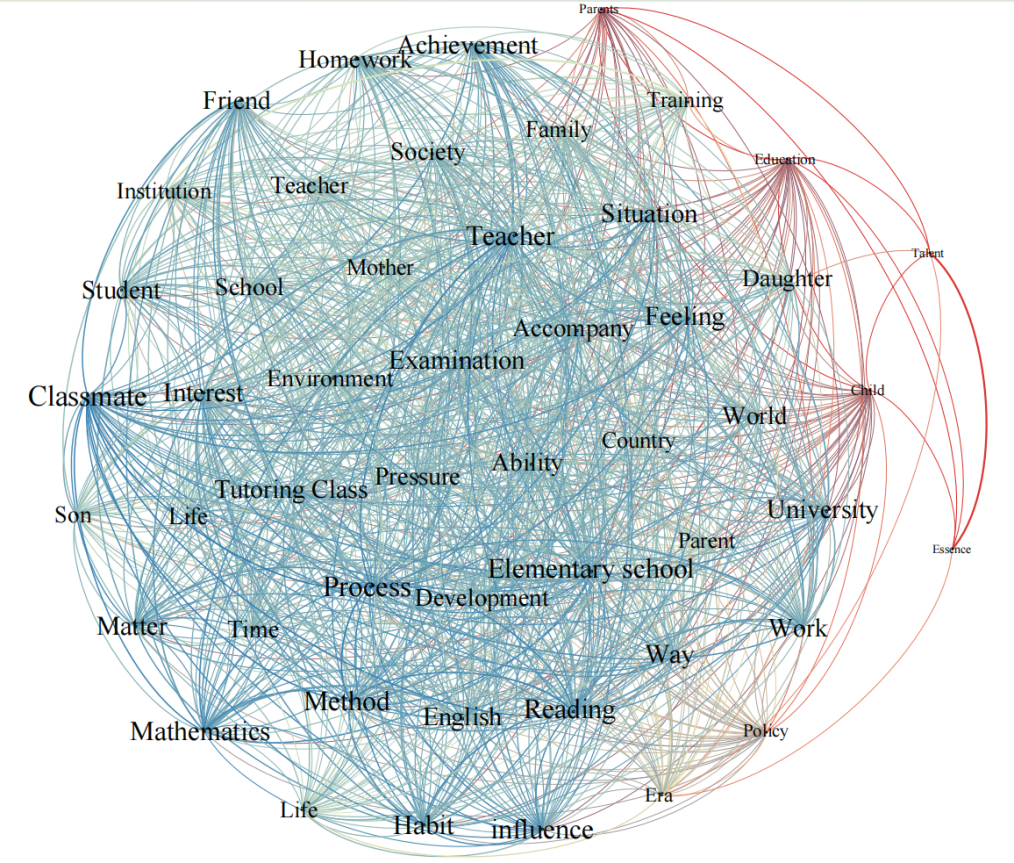
Figure 1: Visualisation of Word2vec Model Results
2.2.Result
Table 1: Indicator assessment of similarity and strength of linkages between selected keywords
|
keyword |
degree |
weighted degree |
modularity_class |
|
Parent |
30 |
0.258 |
0 |
|
Education |
43 |
2.390 |
2 |
|
Essence |
5 |
2.594 |
2 |
|
Talent |
6 |
2.807 |
2 |
|
Child |
43 |
3.102 |
1 |
|
Policy |
42 |
11.459 |
0 |
|
Era |
44 |
15.096 |
3 |
|
Parent (guardian) |
47 |
20.018 |
0 |
The "Parent - Child" relationship reflects the core dynamic in parent-child relations, namely the close bond and mutual influence between parents and children. The words "Parent - Mother/Father" are found in Modularity Classes 0 or 1, indicating their strong association with parent-child relations, with a high connection intensity. This highlights the significance of the parental role in parent-child relations. "Education - Training" refers to the close relationship between the educational environment and training activities in the parent-child relationship, indicating the importance of family education in children's training. "Parents - Era" likely refers to changes in the parent-child relationship across different times, with a higher degree of association between parents and the era, though not directly conceptually linked. "Child - Life" reflects the parents' concern about their children's growth and life paths. Although not directly conceptually related, there is a close connection within the parent-child relationship. "Family - Child/Son/Daughter" appears in Modularity Class 3, but these words remain highly relevant to parent-child relations, indicating the significant influence of the family environment on children's growth, even though not conceptually similar. "Family - Talent" indicates a relationship between family and talent development, although this connection is weaker compared to other pairs. "Education - Parent/Mother/Father" appears in Modularity Class 2, but these terms are more loosely related to parent-child relations, possibly reflecting public attention to education and the parental role, though the direct connection is not obvious.
3.Study 2: Key Predictive Factors of Parent-Child Relationships and Their Changes
Through preliminary prediction of text data, word vectors can capture similarities and contextual associations between words, providing foundational features for many NLP tasks. However, the impact mechanisms and evolution paths of educational policy changes on parent-child relationships remain unclear. Study 2 introduces the time dimension and, based on the Word2Vec model, delves deeper by constructing a DTM dynamic topic model.
3.1.Methodology
3.1.1.Time Slice Division
The text data were organized and analyzed for trends over time. The data were divided into four different stages: Initial Stage: The preparation and drafting phase of the policy, from October 2020 to 2021; Adjustment Stage: The implementation and adjustment phase of the policy, from January 2021 to 2022; Latent Stage: The slow-growth phase of the policy affected by the pandemic, from January 2022 to 2023; Deepening Stage: The accelerated deepening phase of the policy, from January 2023 to December 2023.
3.1.2.Topic Intensity Calculation
The support indicator is mainly used to reveal the strength of a topic, reflecting the attention the topic receives in a given time period. The “Document-Topic” matrix from the DTM model gives the probability of each document belonging to a specific topic. The support indicator calculates the topic intensity using the following formula:
\( TI_{t}^{k}=\frac{Doc_{t}^{k}}{{Doc_{t}}} \)(1)
\( TI_{t}^{k} \)represents the intensity of topic k at time slice t, where the denominator is the total number of documents at time slice t, and the numerator is the number of documents supporting topic k at time slice t. The larger the value\( TI_{t}^{k} \), the higher the topic intensity.
3.1.3.Topic Similarity Calculation
Topic similarity represents how similar two documents are. Similarity is calculated by comparing the topic probability distributions of the two documents. This study uses the Hellinger function from the Gensim library to calculate the similarity between topics at different stages and constructs a Sankey diagram to visualize the evolution path of the “Double Reduction” policy themes.
3.1.4.Determining the Optimal Number of Topics
The number of topics is crucial for topic extraction in literature. This study calculates the topic coherence across four stages with different topic counts to determine the optimal number of topics in the DTM model. The average topic coherence was highest when the number of topics was set to 7, so the model’s number of topics was set to 7.
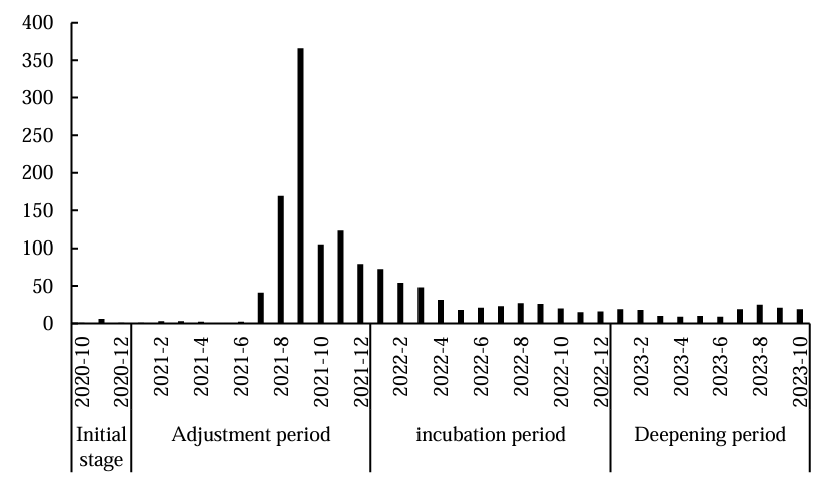
Figure 2: Trend of Text Data Changes
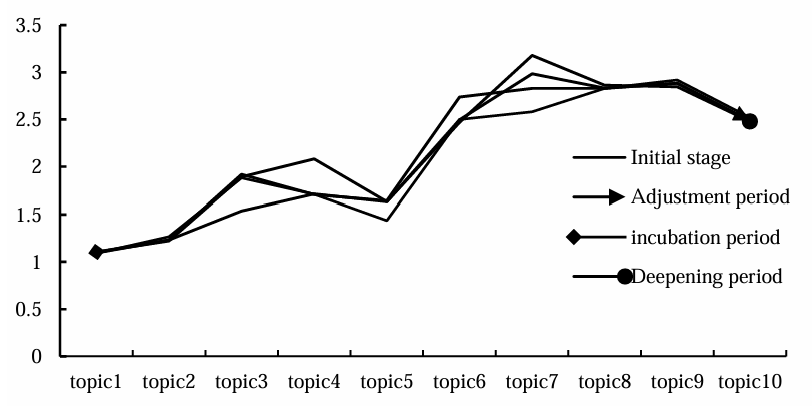
Figure 3: Topic Coherence
3.2.Results
3.2.1.Horizontal Topic Analysis
By training the DTM model on the text data from different stages, a “Topic-Word Matrix” and word weights for each stage of the “Double Reduction” policy were obtained. The top 10 words with the highest average weight from each stage were selected as keywords for each topic. The theme model provides multiple research perspectives, including parent guidance and education, family roles and parent-child relationships, educational policy and family influences, educational environments and growth, teacher-student relationships and knowledge transfer, parental cognition and responsibility anxiety, and work-life balance.
In the multidimensional study of parent-child relationships, parents play an important role in guiding children's learning and growth. The educational methods and involvement of parents affect children's ability development and social adaptability [34,35]. Additionally, family role division is closely linked to parent-child relationships, as interactions between parents and children affect the family atmosphere and communication [36,37]. On the other hand, government educational policies influence not only the school educational environment but also shape family education concepts and parental behavior patterns [38].
Table 2: DTM Topic Model
|
Topic Number |
Topic Identifier |
Keywords |
|
1 |
Parental Guidance and Education |
Child, Learning, Parent, Time, Education, Parent (guardian), Society, Mathematics, Ability, Life, School |
|
2 |
Family Roles and Parent-Child Relationships |
Child, Daughter, Parent, Education, Li Yong, Two People, Father, Ha Wen, Wang Shiling |
|
3 |
Educational Policy and Family Impact |
Child, Education, Parent, Double Reduction, Teacher, Parent (guardian), Screening, School, Learning, Policy |
|
4 |
Educational Environment and Growth |
Child, Teacher, Young Child, School, Parent, Education, Chen Guo, Parent (guardian), China, Childhood |
|
5 |
Teacher-Student Relationships and Knowledge Transfer |
Teacher, Li Shen, Child, Author, Parent, Student, Life, This Song, Knowledge, Work |
|
6 |
Parental Cognition and Responsibility Anxiety |
Child, Parent (guardian), Learning, Double Reduction, Education, Policy, Student, Anxiety, Parent, Training |
|
7 |
Work-Life Balance |
Work, Child, Parent (guardian), Education, Teacher, Industry, Life, Really, Student, Choice, Mother |
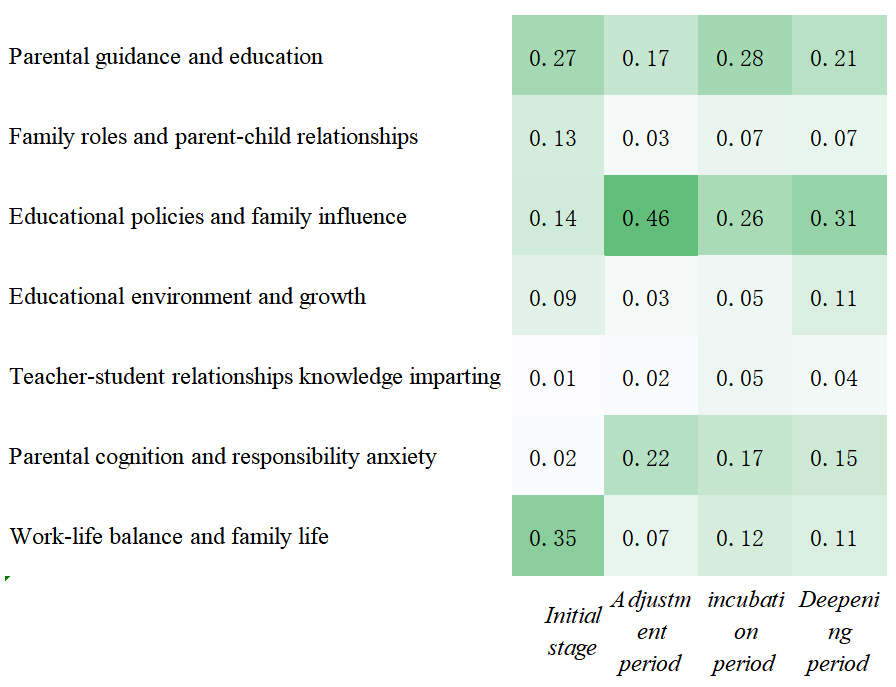
Figure 4: Topic Stage Heatmap
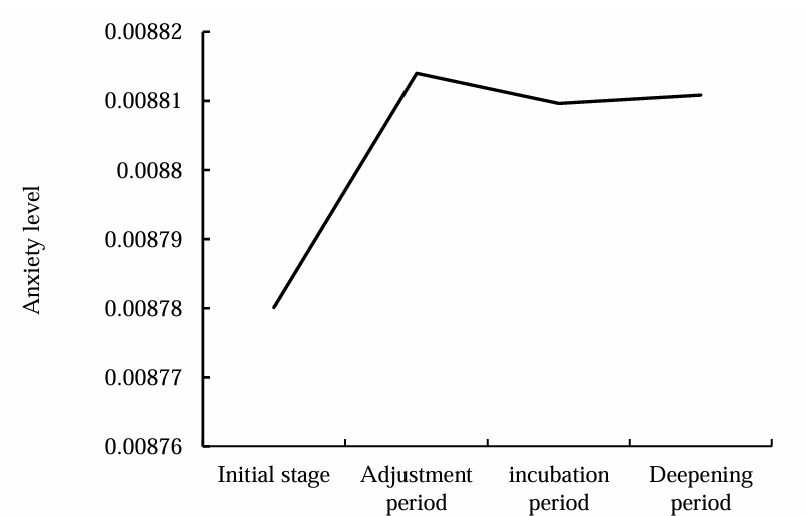
Figure 5: Anxiety Level Changes under the Theme of Parental Cognition and Responsibility Anxiety
3.2.2.Topic Hotness Analysis
The topic hotness for each phase was calculated using Formula (1), and the results were presented in a heatmap to reflect the hot topics during different stages of the "Double Reduction" policy. In the early phase, parents focused on balancing work and family education. They were particularly concerned about how to guide their children’s learning and development while managing a busy work-life schedule [39, 40].
As the education policy was adjusted, it directly affected the evolution of parent-child relationships. The adjustment phase highlighted how changes in education policy influenced family education methods and parent-child relationships. Parents needed to adapt to new policy requirements while managing the impact on family life, which could cause internal tensions.
Parental cognition and responsibility anxiety were significant factors in the changes of parent-child relationships. Policy adjustments triggered changes in parental cognition and anxiety [41,42]. Research showed that parents often experienced anxiety when adapting to new education policies, unsure of how their children would fare under the new system. Early on, anxiety levels surged but stabilized over time.
During the latent and deepening phases, the stability of family roles and educational environments continued to influence parent-child relationships. Themes related to parental cognition, family roles, and educational environments remained stable, suggesting that parents' roles and the family environment had a lasting impact on children's growth and family dynamics.
3.2.3.Topic Evolution Path Analysis
To simplify the topic evolution path, low-hotness topics were filtered out, and the threshold for hotness was set at 0.045. Then, topics with a similarity threshold of 0.3 were further filtered. This led to the creation of the topic evolution path using a Sankey diagram.
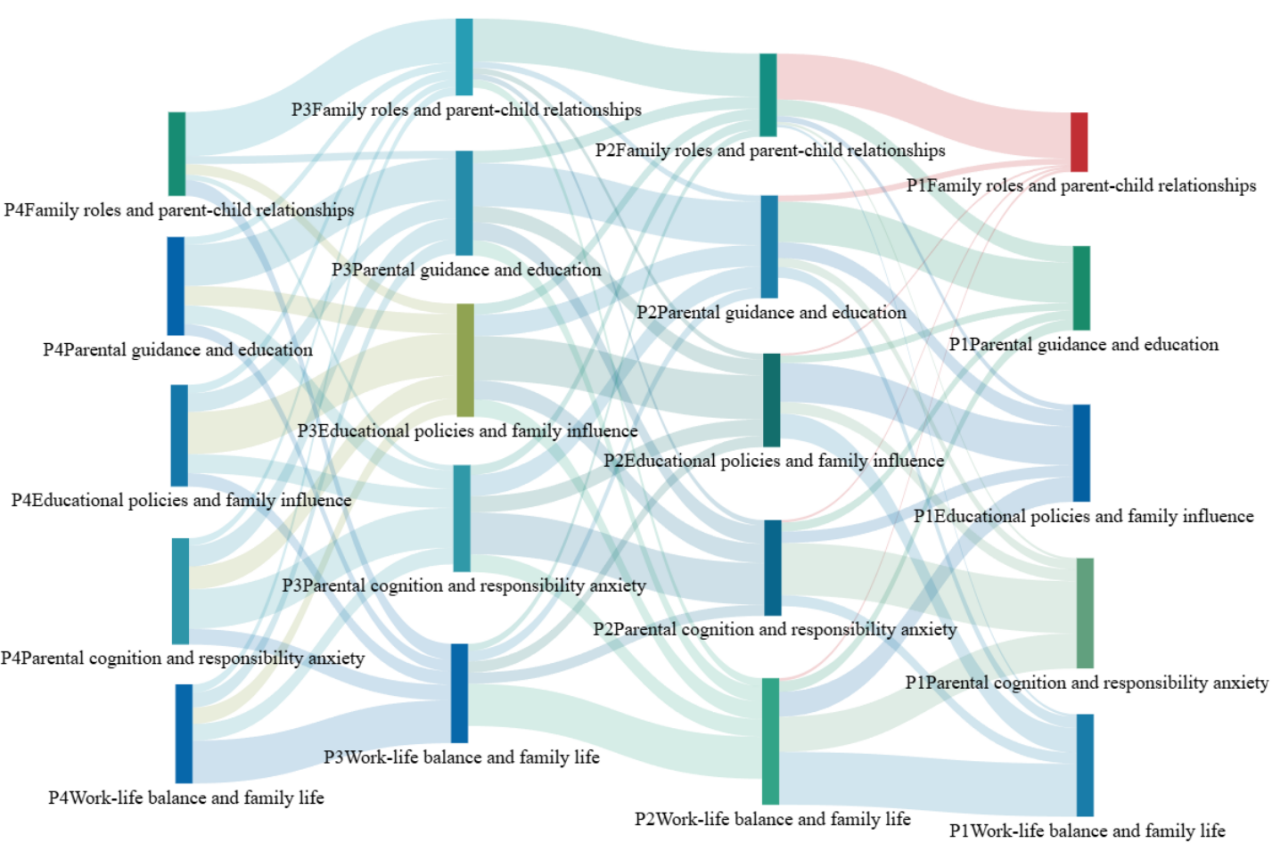
Figure 6: Topic Evolution Path of the "Double Reduction" Policy

Figure 7: Evolution of Keywords under the Theme of "Work and Family Balance"
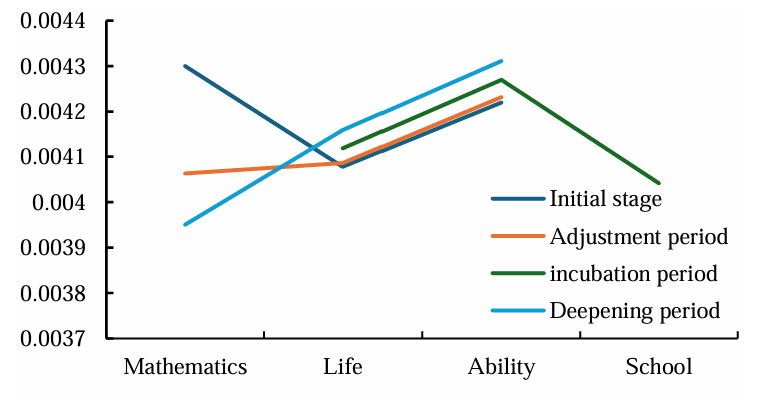
Figure 8: Evolution of Keywords under the Theme of "Parental Guidance and Education"
The Critical Role of Mothers in Establishing Healthy Parent-Child Relationships. In the context of the "Work-Life Balance" theme, an analysis of keywords such as "work," "children," "parents," "education," along with additional mentions of "mother" and "choice," reveals that mothers play a vital role in parent-child relationships. During the early and adjustment phases, the keyword "work" is highly significant, indicating that mothers face challenges in balancing work and family life under the "Double Reduction" policy. This reflects the pressures and challenges mothers experience in adapting to new roles and responsibilities. At the same time, "children" and "parents" are also prominent keywords, indicating mothers' focus on family responsibilities. In the adjustment phase, mothers are likely to focus more on family matters and the educational needs of their children, aiming to ensure family stability and the children's happiness. "Education" remains a significant keyword, though slightly lower in weight, indicating that mothers are concerned with educational issues, including educational methods and resource selection. During the latent and deepening phases, while "work" remains a keyword, its weight might slightly decrease, suggesting that mothers have managed to achieve a better balance between work and family life. They may become more effective in managing time and energy to meet both work and family demands. Keywords like "students," "parents," and "education" remain stable, showing that these are ongoing concerns for mothers throughout the process.
The focus of parental education gradually shifted as time passed and the "Double Reduction" policy was implemented. In the early stage, parents primarily focused on children's academic performance and the time and attention devoted to their growth, reflecting traditional educational views and the emphasis on academic achievements. With social changes and policy adjustments, educational concepts began to evolve. In the adjustment phase, parents started paying more attention to educational methods and their role in their children's education. This indicated a shift in parents' educational philosophy and an increased focus on family education. In the latent phase, words like "society" and "ability" started to appear more frequently, suggesting that parents were beginning to emphasize developing their children's comprehensive skills for success in society. Finally, in the deepening phase, parents became increasingly focused on their children's lifestyles and overall development, signaling a further shift in educational philosophy, emphasizing the cultivation of life skills and well-rounded abilities. This marked a transition from the traditional focus on academic achievement to a focus on holistic development and comprehensive education, reflecting changes in educational views and societal influences.
The analysis of the "Family Roles and Parent-Child Relationships" theme shows how external factors influence the roles and interactions between parents and children. In the early phase, parents are likely to focus more on their roles as caregivers and guides, concentrating on meeting their children's basic needs and building close emotional connections. Interactions during this phase are mainly centered around emotional communication and organizing daily family life. As the adjustment phase begins, parents' roles may shift to a greater emphasis on being educators, with a focus on children's education and growth. Parents may pay more attention to the choice of educational methods and the shaping of the family education environment to better promote their children's development. As the latent phase progresses, interactions between parents and children might be influenced by external factors, such as social events or specific cases, leading parents to rethink and adjust their parent-child relationships. This may cause some changes in the roles and interactions between parents and children. By the deepening phase, parents might become more concerned with their children's future development, including education and career planning, potentially taking on more of a guiding and supportive role. Together with their children, parents would aim to set future goals and plans for their growth and success.
Over time, the roles and interactions between parents and children are likely to evolve from early emotional exchanges and basic caregiving to a more focused approach on education and future planning, shaped by external influences and changes in family dynamics.
4.Discussion
4.1.The Implementation of the "Double Reduction" Policy as a Key Factor Influencing Changes in Parenting Approaches and Role Choices
Through the analysis using the DTM dynamic topic model, the study reveals that the implementation of the "Double Reduction" policy has significantly influenced parents in adjusting their educational methods and role choices. In the initial phase, parents primarily focused on balancing work and family life, showing concern for their children's learning and growth, while also reflecting the challenges of managing both work and family responsibilities. As the policy adjusted, parents began to focus more on the impact of the policy changes on family life and educational methods. Over time, they gradually shifted from an academic achievement-oriented approach to one that emphasizes holistic development and the cultivation of comprehensive skills. During the latent and deepening phases, keywords like "society" and "ability" became more prominent, further highlighting parents' increasing focus on developing their children's social adaptability. This reflects an evolution in educational philosophies. Therefore, the educational methods and role choices of parents under the "Double Reduction" policy are clearly influenced by policy changes.
4.2.Cognitive and Responsibility Anxiety Experienced by Parents During the Adjustment to the "Double Reduction" Policy, and Its Impact on Their Roles and Behaviors in Parent-Child Relationships
The study indicates that during the adjustment phase of the "Double Reduction" policy, parents generally experience changes in their cognitive level and responsibility anxiety. The policy changes not only affect parents' daily life and work arrangements but also present them with the challenge of adapting to the new policy requirements. Parents may feel uneasy about their children's learning and development under the new policy, and this anxiety can lead to adjustments in the roles and behaviors of parents in their parent-child relationships. In particular, during the policy adjustment period, parents' anxiety may influence their decisions and implementation in family education, which in turn affects the stability and quality of the parent-child relationship.
4.3.Limitations and Suggestions
While current research shows that factors such as gender, grade level, and socio-economic status do not have a significant impact on parent-child relationships, this does not imply that there are no individual differences in these relationships. To understand the complexity of changes in parent-child relationships, it is essential to consider both the internal dynamics of the family and the external policy environment. Future research could explore other potential factors, such as cultural background and family educational styles, to gain a more comprehensive understanding of the changing patterns of parent-child relationships under the "Double Reduction" policy and their driving forces. It is suggested to employ case study methods to analyze the dynamic changes in parent-child relationships within specific families and the influencing factors, in order to draw more detailed and concrete conclusions, providing more precise guidance for family education and policy formulation.
5.Conclusion
(1) Early stages of policy implementation: Parents focus more on balancing work and family life. Over time, they shift their attention to their children's overall development and the cultivation of social skills.
(2) During policy adjustment: Parents experience changes in cognitive levels and responsibility anxiety. These emotions play a central role in adjusting the roles and interactions with their children. Parents gradually realize that an excessive emphasis on academic achievement may have negative effects on their children's physical and mental well-being. As a result, they start focusing more on cultivating their children's comprehensive abilities and qualities, transitioning from a traditional caregiving role to one that emphasizes education and future planning.
Acknowledgement
Data Availability:
All data can be obtained by contacting the author.
Conflict of Interest:
The authors declare that there are no conflicts of interest.
References
[1]. "Double Reduction" policy, parent-child relationship, natural language processing (NLP)
[2]. Xu, H., & Wang, X. (2023). Noise level in two-child families and preschoolers' prosocial behavior: The chain mediating role of parent-child and sibling relationships. Chinese Journal of Clinical Psychology, 31(6), 1391–1394+1399. https://doi.org/10.16128/j.cnki.1005-3611.2023.06.019
[3]. Zhan, P., et al. (2021). The impact of parent-child relationships on parental mental health: The chain mediating role of parenting stress and parenting efficacy. Chinese Journal of Clinical Psychology, 29(1), 123–127. https://doi.org/10.16128/j.cnki.1005-3611.2021.01.024
[4]. Zhou, H., Liu, Z., Fan, Y., & Li, B. (2019). Parent-child relationships and cyberbullying among junior high school students: The mediating role of loneliness. Journal of Psychological Science, 17(6), 787–794.
[5]. Bird, A., et al. (2024). Talking, praising, and teaching: How parent interaction during a learning task relates to children's early learning. Early Childhood Research Quarterly, 66, 255–268. https://doi.org/10.1016/j.ecresq.2023.10.001
[6]. Egger, S., et al. (2024). Parents’ awareness of, and influence on, their 14–17-year-old child's vaping and smoking behaviors: An analysis of 3,242 parent-child pairs in Australia. Addictive Behaviors, 150, 107931. https://doi.org/10.1016/j.addbeh.2023.107931
[7]. Hu, Y., et al. (2023). The effects of parent-child relationships and parental educational involvement on adolescent depression, self-harm, and suicidal ideation: The roles of frustration and sense of meaning in life. Acta Psychologica Sinica, 55(2), 129–141.
[8]. Li, Z., Zhu, X., Tang, Z., & Li, T. (2020). Parent-child relationships and adolescent cyberbullying: A moderated mediation model. Chinese Journal of Clinical Psychology, 28(5), 986–990. https://doi.org/10.16128/j.cnki.1005-3611.2020.05.026
[9]. Liu, L., Tian, L., & Guo, J. (2019). The impact of parent-child relationships on adolescent risk-taking behaviors: A moderated mediation model. Psychological Development and Education, 35(2), 210–218. https://doi.org/10.16187/j.cnki.issn1001-4918.2019.02.10
[10]. Lü, J., Zheng, H., Xiao, L., & Fu, L. (2022). Perceived differences in parent-child relationship problems: A latent profile analysis based on 10,673 parent-child paired data. Chinese Journal of Health Psychology, 30(12), 1877–1882. https://doi.org/10.13342/j.cnki.cjhp.2022.12.023
[11]. Lamela, D., et al. (2024). Mother-child reporting discrepancies of child physical abuse: Associations with internalizing and externalizing symptoms. Child Abuse & Neglect, 147, 106575. https://doi.org/10.1016/j.chiabu.2023.106575
[12]. Kedzior, S. G. E., et al. (2024). “They had clothes on their back and they had food in their stomach, but they didn't have me”: The contribution of parental mental health problems, substance use, and domestic violence and abuse on young people and parents. Child Abuse & Neglect, 149, 106609. https://doi.org/10.1016/j.chiabu.2023.106609
[13]. Labelle, L., et al. (2024). Associations between socioeconomic status, child risk factors, and parenting during guided learning. Journal of Applied Developmental Psychology, 91, 101633. https://doi.org/10.1016/j.appdev.2024.101633
[14]. Marwitz, U., Higgins, D. J., & Whelan, T. (2024). “Kids are in the middle of it” – Child protection practitioners reflect on indicators of coercive control and situational couple violence. Children and Youth Services Review, 160, 107596. https://doi.org/10.1016/j.childyouth.2024.107596
[15]. Kuang, H. (2019). Psychological capital of rural left-behind junior high school students: The influence of individuals, families, and schools. Shanghai Educational Research, 45, 45–49+16. https://doi.org/10.16194/j.cnki.31-1059/g4.2019.06.012
[16]. Liu, C., Wang, M., & Tang, M. (2022). Parent-child communication and learning engagement of migrant children: The mediating role of family intimacy and peer relationships. Chinese Journal of Health Psychology, 30(8), 1261–1265. https://doi.org/10.13342/j.cnki.cjhp.2022.08.028
[17]. Xu, W., Fang, Y., & Ye, C. (2022). The impact of early family cumulative risk on adolescent internalizing problems. Psychological Development and Education, 38(6), 793–803. https://doi.org/10.16187/j.cnki.issn1001-4918.2022.06.05
[18]. Neve, K. L., et al. (2024). What shapes parental feeding decisions over the first 18 months of parenting: Insights into drivers towards commercial and home-prepared foods among different socioeconomic groups in the UK. Appetite, 196, 107260. https://doi.org/10.1016/j.appet.2024.107260
[19]. Mäder, S. J., et al. (2024). Intra- and interpersonal influences on child adjustment and resilience in welfare care: A qualitative study with former caregivers in Switzerland. Children and Youth Services Review, 161, 107653. https://doi.org/10.1016/j.childyouth.2024.107653
[20]. Brauchli, V., et al. (2024). Are screen media the new pacifiers? The role of parenting stress and parental attitudes for children's screen time in early childhood. Computers in Human Behavior, 152, 108057. https://doi.org/10.1016/j.chb.2023.108057
[21]. Leeuw, A. E. d., Ester, W. A., Bolhuis, K., Hoek, H. W. & Jansen, P. W. (2024). Maternal Migration, Prenatal Stress and Child Autistic Traits: Insights From a Population-Based Cohort Study. doi:10.1016/j.jaac.2024.04.004.
[22]. Liang, R. & Leeuwen, K. V. (2024). Psychometric properties of the Mobile Phone Parenting Practices Questionnaire (MPPPQ) for Chinese separated families with young children. 244, 104197, doi:10.1016/j.actpsy.2024.104197.
[23]. Mathews, B. et al. (2024). Child sexual abuse by different classes and types of perpetrator: Prevalence and trends from an Australian national survey. 147, 106562, doi:10.1016/j.chiabu.2023.106562.
[24]. Mauri, D. (2024). Constructing the ‘zero family’: Breaking the intergenerational transmission of maltreatment from the perspective of care-experienced parents. 153, 106855, doi:10.1016/j.chiabu.2024.106855.
[25]. Kähkönen, J. E., Lionetti, F., Castelli, L. & Pluess, M. (2024). Development and validation of the highly sensitive child interview for the assessment of environmental sensitivity in primary school children. Personality and Individual Differences. 222, 112592, doi:10.1016/j.paid.2024.112592.
[26]. Boukobza, A., Burgun, A., Roudier, B. & Tsopra, R. (2022). Deep Neural Networks for Simultaneously Capturing Public Topics and Sentiments During a Pandemic: Application on a COVID-19 Tweet Data Set. JMIR Med Inform. 10, e34306, doi:10.2196/34306.
[27]. Sandu, A., Cotfas, L.-A., Delcea, C., Crăciun, L., & Molănescu, A. G. (2023). Sentiment Analysis in the Age of COVID-19: A Bibliometric Perspective. Information 14, 659, doi:https://doi.org/10.3390/info14120659.
[28]. Amara, A., Hadj Taieb, M. A. & Ben Aouicha, M. (2021). Multilingual topic modeling for tracking COVID-19 trends based on Facebook data analysis. Applied Intelligence 51, 3052-3073, doi:10.1007/s10489-020-02033-3.
[29]. García-Garcia, A. M., Tapia-Hernández, J. & Piñón Vargas, M. (2020). Análisis de los emprendimientos trending exitosos en Kickstarter México y sus redes de difusión de la campaña. Vinculatégica EFAN. 6, 144-157, doi:10.29105/vtga6.1-555.
[30]. Mulavu, M. et al. (2023). Psychosocial challenges and coping strategies among people with minority gender and sexual identities in Zambia: health promotion and human rights implications. Health Psychology and Behavioral Medicine. 11, 2173201, doi:10.1080/21642850.2023.2173201.
[31]. Li, Z. (2024). Leveraging AI automated emergency response with natural language processing: Enhancing real-time decision making and communication. Applied and Computational Engineering 71, 1-6.
[32]. Lee, J. et al. (2024). Automated Testing Linguistic Capabilities of NLP Models. 33, Article 176, doi:10.1145/3672455.
[33]. Tenney, I., Das, D. & Pavlick, E. (2019). Proceedings of the 57th Annual Meeting of the Association for Computational Linguistics. Association for Computational Linguistics, 4593–4601, doi:10.18653/v1/P19-1452.
[34]. Chen, W., Fang, M., Sun, Y., & He, Y. (2024). The relationship between parental conflict and interpersonal conflict resolution strategies in college students: The mediating role of the parent-child triangle and gender differences. Journal of Psychology, 32, 142-148. https://doi.org/10.16128/j.cnki.1005-3611.2024.01.026
[35]. Chen, X. P., & An, L. (2019). The influence of paternal co-parenting on children's prosocial behavior: The mediating role of security and interpersonal trust. Journal of Psychology, 27, 803-807. https://doi.org/10.16128/j.cnki.1005-3611.2019.04.034
[36]. Gao, W., Wang, Y. H., Fang, Z., & Liu, M. Y. (2019). The role of parent-child triangle and psychological resilience in the relationship between parental conflict and adolescent problem behaviors: A moderated mediation model. Journal of Adolescent Studies, 35, 729-739. https://doi.org/10.16187/j.cnki.issn1001-4918.2019.06.10
[37]. Hu, J. P., & Zhong, D. H. (2019). The relationship between parent-child closeness and adolescents' prosocial tendencies: The mediating role of self-compassion and emotion regulation strategies. Psychological Research, 89-96.
[38]. Liao, J. Q., et al. (2023). The impact of family and school interpersonal relationships on the social adaptation ability of left-behind children: The mediating role of self-esteem and life satisfaction. Journal of Educational Psychology, 45, 2-11. https://doi.org/10.13718/j.cnki.xdzk.2023.12.001
[39]. Ranzani, F. (2024). "Doing being a good parent" in the pediatric clinic: Parents' knowledge displays in advice requests on baby's everyday care. 116964, doi:10.1016/j.socscimed.2024.116964.
[40]. Poortvliet, M. v.(2024). Child mental health and educational attainment: Longitudinal evidence from the UK. 5,100294, doi:10.1016/j.ssmmh.2023. 100294.
[41]. Elnagar, A. & Young, J. (2021). International Education and the Internationalization of Public Schooling in Canada: Approaches and Conceptualizations. Canadian Journal of Educational Administration and Policy / Revue canadienne en administration et politique de l' éducation, 80-94, doi:https://doi.org/10.7202/1075674ar.
[42]. Zhou, Y. (2023). Middle class educational anxiety and its resolution path under the background of "double reduction" . SHS Web Conf. 158.
Cite this article
Wang,S. (2025). Application of Natural Language Processing Methods in Exploring Changes in Parent-Child Relationships under the "Double Reduction" Policy and Their Key Predictors. Lecture Notes in Education Psychology and Public Media,82,81-94.
Data availability
The datasets used and/or analyzed during the current study will be available from the authors upon reasonable request.
Disclaimer/Publisher's Note
The statements, opinions and data contained in all publications are solely those of the individual author(s) and contributor(s) and not of EWA Publishing and/or the editor(s). EWA Publishing and/or the editor(s) disclaim responsibility for any injury to people or property resulting from any ideas, methods, instructions or products referred to in the content.
About volume
Volume title: Proceedings of the 3rd International Conference on Social Psychology and Humanity Studies
© 2024 by the author(s). Licensee EWA Publishing, Oxford, UK. This article is an open access article distributed under the terms and
conditions of the Creative Commons Attribution (CC BY) license. Authors who
publish this series agree to the following terms:
1. Authors retain copyright and grant the series right of first publication with the work simultaneously licensed under a Creative Commons
Attribution License that allows others to share the work with an acknowledgment of the work's authorship and initial publication in this
series.
2. Authors are able to enter into separate, additional contractual arrangements for the non-exclusive distribution of the series's published
version of the work (e.g., post it to an institutional repository or publish it in a book), with an acknowledgment of its initial
publication in this series.
3. Authors are permitted and encouraged to post their work online (e.g., in institutional repositories or on their website) prior to and
during the submission process, as it can lead to productive exchanges, as well as earlier and greater citation of published work (See
Open access policy for details).
References
[1]. "Double Reduction" policy, parent-child relationship, natural language processing (NLP)
[2]. Xu, H., & Wang, X. (2023). Noise level in two-child families and preschoolers' prosocial behavior: The chain mediating role of parent-child and sibling relationships. Chinese Journal of Clinical Psychology, 31(6), 1391–1394+1399. https://doi.org/10.16128/j.cnki.1005-3611.2023.06.019
[3]. Zhan, P., et al. (2021). The impact of parent-child relationships on parental mental health: The chain mediating role of parenting stress and parenting efficacy. Chinese Journal of Clinical Psychology, 29(1), 123–127. https://doi.org/10.16128/j.cnki.1005-3611.2021.01.024
[4]. Zhou, H., Liu, Z., Fan, Y., & Li, B. (2019). Parent-child relationships and cyberbullying among junior high school students: The mediating role of loneliness. Journal of Psychological Science, 17(6), 787–794.
[5]. Bird, A., et al. (2024). Talking, praising, and teaching: How parent interaction during a learning task relates to children's early learning. Early Childhood Research Quarterly, 66, 255–268. https://doi.org/10.1016/j.ecresq.2023.10.001
[6]. Egger, S., et al. (2024). Parents’ awareness of, and influence on, their 14–17-year-old child's vaping and smoking behaviors: An analysis of 3,242 parent-child pairs in Australia. Addictive Behaviors, 150, 107931. https://doi.org/10.1016/j.addbeh.2023.107931
[7]. Hu, Y., et al. (2023). The effects of parent-child relationships and parental educational involvement on adolescent depression, self-harm, and suicidal ideation: The roles of frustration and sense of meaning in life. Acta Psychologica Sinica, 55(2), 129–141.
[8]. Li, Z., Zhu, X., Tang, Z., & Li, T. (2020). Parent-child relationships and adolescent cyberbullying: A moderated mediation model. Chinese Journal of Clinical Psychology, 28(5), 986–990. https://doi.org/10.16128/j.cnki.1005-3611.2020.05.026
[9]. Liu, L., Tian, L., & Guo, J. (2019). The impact of parent-child relationships on adolescent risk-taking behaviors: A moderated mediation model. Psychological Development and Education, 35(2), 210–218. https://doi.org/10.16187/j.cnki.issn1001-4918.2019.02.10
[10]. Lü, J., Zheng, H., Xiao, L., & Fu, L. (2022). Perceived differences in parent-child relationship problems: A latent profile analysis based on 10,673 parent-child paired data. Chinese Journal of Health Psychology, 30(12), 1877–1882. https://doi.org/10.13342/j.cnki.cjhp.2022.12.023
[11]. Lamela, D., et al. (2024). Mother-child reporting discrepancies of child physical abuse: Associations with internalizing and externalizing symptoms. Child Abuse & Neglect, 147, 106575. https://doi.org/10.1016/j.chiabu.2023.106575
[12]. Kedzior, S. G. E., et al. (2024). “They had clothes on their back and they had food in their stomach, but they didn't have me”: The contribution of parental mental health problems, substance use, and domestic violence and abuse on young people and parents. Child Abuse & Neglect, 149, 106609. https://doi.org/10.1016/j.chiabu.2023.106609
[13]. Labelle, L., et al. (2024). Associations between socioeconomic status, child risk factors, and parenting during guided learning. Journal of Applied Developmental Psychology, 91, 101633. https://doi.org/10.1016/j.appdev.2024.101633
[14]. Marwitz, U., Higgins, D. J., & Whelan, T. (2024). “Kids are in the middle of it” – Child protection practitioners reflect on indicators of coercive control and situational couple violence. Children and Youth Services Review, 160, 107596. https://doi.org/10.1016/j.childyouth.2024.107596
[15]. Kuang, H. (2019). Psychological capital of rural left-behind junior high school students: The influence of individuals, families, and schools. Shanghai Educational Research, 45, 45–49+16. https://doi.org/10.16194/j.cnki.31-1059/g4.2019.06.012
[16]. Liu, C., Wang, M., & Tang, M. (2022). Parent-child communication and learning engagement of migrant children: The mediating role of family intimacy and peer relationships. Chinese Journal of Health Psychology, 30(8), 1261–1265. https://doi.org/10.13342/j.cnki.cjhp.2022.08.028
[17]. Xu, W., Fang, Y., & Ye, C. (2022). The impact of early family cumulative risk on adolescent internalizing problems. Psychological Development and Education, 38(6), 793–803. https://doi.org/10.16187/j.cnki.issn1001-4918.2022.06.05
[18]. Neve, K. L., et al. (2024). What shapes parental feeding decisions over the first 18 months of parenting: Insights into drivers towards commercial and home-prepared foods among different socioeconomic groups in the UK. Appetite, 196, 107260. https://doi.org/10.1016/j.appet.2024.107260
[19]. Mäder, S. J., et al. (2024). Intra- and interpersonal influences on child adjustment and resilience in welfare care: A qualitative study with former caregivers in Switzerland. Children and Youth Services Review, 161, 107653. https://doi.org/10.1016/j.childyouth.2024.107653
[20]. Brauchli, V., et al. (2024). Are screen media the new pacifiers? The role of parenting stress and parental attitudes for children's screen time in early childhood. Computers in Human Behavior, 152, 108057. https://doi.org/10.1016/j.chb.2023.108057
[21]. Leeuw, A. E. d., Ester, W. A., Bolhuis, K., Hoek, H. W. & Jansen, P. W. (2024). Maternal Migration, Prenatal Stress and Child Autistic Traits: Insights From a Population-Based Cohort Study. doi:10.1016/j.jaac.2024.04.004.
[22]. Liang, R. & Leeuwen, K. V. (2024). Psychometric properties of the Mobile Phone Parenting Practices Questionnaire (MPPPQ) for Chinese separated families with young children. 244, 104197, doi:10.1016/j.actpsy.2024.104197.
[23]. Mathews, B. et al. (2024). Child sexual abuse by different classes and types of perpetrator: Prevalence and trends from an Australian national survey. 147, 106562, doi:10.1016/j.chiabu.2023.106562.
[24]. Mauri, D. (2024). Constructing the ‘zero family’: Breaking the intergenerational transmission of maltreatment from the perspective of care-experienced parents. 153, 106855, doi:10.1016/j.chiabu.2024.106855.
[25]. Kähkönen, J. E., Lionetti, F., Castelli, L. & Pluess, M. (2024). Development and validation of the highly sensitive child interview for the assessment of environmental sensitivity in primary school children. Personality and Individual Differences. 222, 112592, doi:10.1016/j.paid.2024.112592.
[26]. Boukobza, A., Burgun, A., Roudier, B. & Tsopra, R. (2022). Deep Neural Networks for Simultaneously Capturing Public Topics and Sentiments During a Pandemic: Application on a COVID-19 Tweet Data Set. JMIR Med Inform. 10, e34306, doi:10.2196/34306.
[27]. Sandu, A., Cotfas, L.-A., Delcea, C., Crăciun, L., & Molănescu, A. G. (2023). Sentiment Analysis in the Age of COVID-19: A Bibliometric Perspective. Information 14, 659, doi:https://doi.org/10.3390/info14120659.
[28]. Amara, A., Hadj Taieb, M. A. & Ben Aouicha, M. (2021). Multilingual topic modeling for tracking COVID-19 trends based on Facebook data analysis. Applied Intelligence 51, 3052-3073, doi:10.1007/s10489-020-02033-3.
[29]. García-Garcia, A. M., Tapia-Hernández, J. & Piñón Vargas, M. (2020). Análisis de los emprendimientos trending exitosos en Kickstarter México y sus redes de difusión de la campaña. Vinculatégica EFAN. 6, 144-157, doi:10.29105/vtga6.1-555.
[30]. Mulavu, M. et al. (2023). Psychosocial challenges and coping strategies among people with minority gender and sexual identities in Zambia: health promotion and human rights implications. Health Psychology and Behavioral Medicine. 11, 2173201, doi:10.1080/21642850.2023.2173201.
[31]. Li, Z. (2024). Leveraging AI automated emergency response with natural language processing: Enhancing real-time decision making and communication. Applied and Computational Engineering 71, 1-6.
[32]. Lee, J. et al. (2024). Automated Testing Linguistic Capabilities of NLP Models. 33, Article 176, doi:10.1145/3672455.
[33]. Tenney, I., Das, D. & Pavlick, E. (2019). Proceedings of the 57th Annual Meeting of the Association for Computational Linguistics. Association for Computational Linguistics, 4593–4601, doi:10.18653/v1/P19-1452.
[34]. Chen, W., Fang, M., Sun, Y., & He, Y. (2024). The relationship between parental conflict and interpersonal conflict resolution strategies in college students: The mediating role of the parent-child triangle and gender differences. Journal of Psychology, 32, 142-148. https://doi.org/10.16128/j.cnki.1005-3611.2024.01.026
[35]. Chen, X. P., & An, L. (2019). The influence of paternal co-parenting on children's prosocial behavior: The mediating role of security and interpersonal trust. Journal of Psychology, 27, 803-807. https://doi.org/10.16128/j.cnki.1005-3611.2019.04.034
[36]. Gao, W., Wang, Y. H., Fang, Z., & Liu, M. Y. (2019). The role of parent-child triangle and psychological resilience in the relationship between parental conflict and adolescent problem behaviors: A moderated mediation model. Journal of Adolescent Studies, 35, 729-739. https://doi.org/10.16187/j.cnki.issn1001-4918.2019.06.10
[37]. Hu, J. P., & Zhong, D. H. (2019). The relationship between parent-child closeness and adolescents' prosocial tendencies: The mediating role of self-compassion and emotion regulation strategies. Psychological Research, 89-96.
[38]. Liao, J. Q., et al. (2023). The impact of family and school interpersonal relationships on the social adaptation ability of left-behind children: The mediating role of self-esteem and life satisfaction. Journal of Educational Psychology, 45, 2-11. https://doi.org/10.13718/j.cnki.xdzk.2023.12.001
[39]. Ranzani, F. (2024). "Doing being a good parent" in the pediatric clinic: Parents' knowledge displays in advice requests on baby's everyday care. 116964, doi:10.1016/j.socscimed.2024.116964.
[40]. Poortvliet, M. v.(2024). Child mental health and educational attainment: Longitudinal evidence from the UK. 5,100294, doi:10.1016/j.ssmmh.2023. 100294.
[41]. Elnagar, A. & Young, J. (2021). International Education and the Internationalization of Public Schooling in Canada: Approaches and Conceptualizations. Canadian Journal of Educational Administration and Policy / Revue canadienne en administration et politique de l' éducation, 80-94, doi:https://doi.org/10.7202/1075674ar.
[42]. Zhou, Y. (2023). Middle class educational anxiety and its resolution path under the background of "double reduction" . SHS Web Conf. 158.





